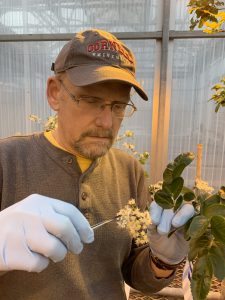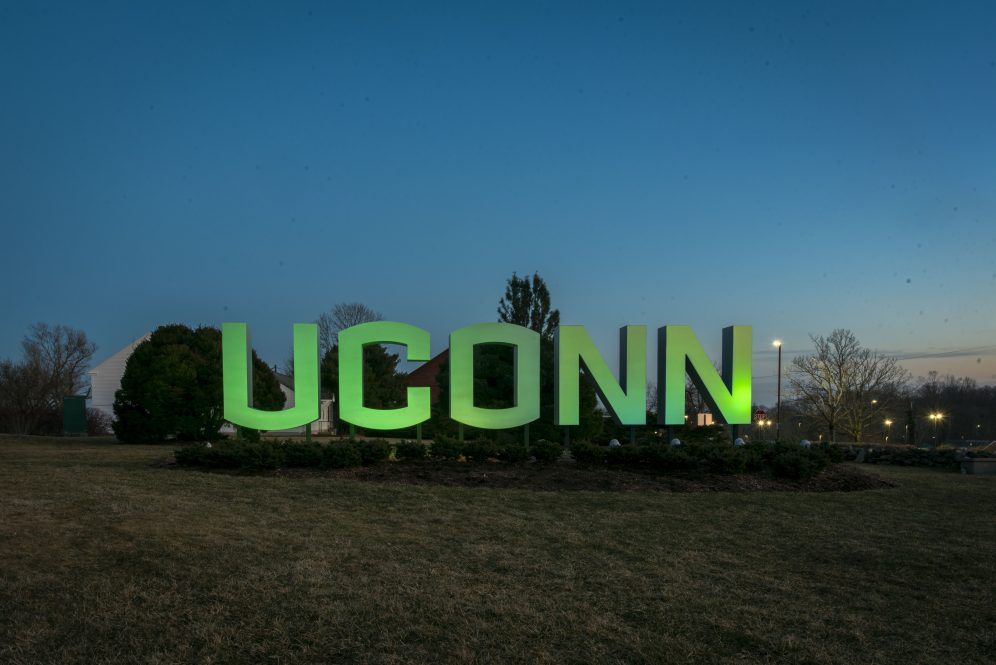UConn horticulture professor Mark Brand grew up in Storrs surrounded by flourishing flower fields and native shrubs. They were a unique breed of “classmates” who planted perennial seeds in his young mind that would later inspire his future.
Today, Brand’s lab at UConn has licensed 27 plants, 33 royalty generating cultivars, 16 plant patents, 33 new plant introductions, and three registered trademarks over the last two decades. Brand has built a 20-year relationship working with UConn’s Technology Commercialization Services (TCS), which helped him license many of his breeds to prominent branding programs including Proven Winners, First Editions, Better Homes & Gardens, Ball Horticulture, and Walmart.
Brand, a UConn legacy whose father was an associate dean at the College of Agriculture, Health and Natural Resources , remembers the “water shed moment” when his first plant, an ornamental grass known as Ruby Ribbons, was patented, and then licensed.

“At the time ornamental grasses were the in thing in landscape plants, they were relatively new. So Ruby Ribbons was patented and licensed by Ball Horticulture, which was very big for us and an international entity. That was a watershed moment where UConn Technology Commercialization realized, oh this might make sense to go down this road,” Brand says. “I had a royalty stream of income coming in so I could continue my work. It opened up my ability to get my plants patented and licensed.”
An element of breeding plants that Brand finds fascinating is conceptualizing an idea that may or may not work.
“When you grow the seedlings up it’s like opening presents, you never know what you’re going to get. You could bomb on everything and it doesn’t work, and other times it’s fascinating seeing what you get as plants grow, reach maturity, and start flowering,” he says.
Brand often prefers growing woody plants such as shrubs, which requires patience as their growth cycle can take time. He appreciates their permanence, knowing that they grow and remain in the landscape for decades, which means they help with climate control, soil stabilization and production, ecosystem water balance, carbon uptake and storage, and biodiversity.
Licensing Plants that Fight Climate Change
Brand hopes to continue breeding and developing ornamental plants that are better equipped to tolerate increasing environmental stresses including drought or heat. He’s also eager to grow more compact plants that work better in increasingly smaller residential yards and landscapes, but can also provide solutions to issues such as invasiveness and support of pollinators.
“I’m trying to create plants that can replace a lot of the plants that we seem to be losing due to climate change, drought, heat, and insects and disease issues that are becoming worse under climate change conditions,” he says.
Ash trees, for example, are one of many plants that he says people used 10 to 20 years ago, but are vanishing from the landscape.

“They’re just one of many. Many species don’t seem to live as long as they used to because now they get a particular disease or insect problem, but in the past you used to get them to grow to be a 50-foot tree. Now, they’re only a 20-foot tree before they succumb,” Brand says.
Going back to his roots as a teenage horticulturist, Brand remains laser focused on growing native plant species.
Initially, he recalls native plants were a tough sell.
“The average person will still want an exotic hydrangea with big giant blue or pink flowers, because some of the native plants on face value are less showy. At garden centers many people go for real glamy-looking plants,” he says, noting that this is changing, and the native market has steadily been growing with more consumers shifting to these plants.
According to the U.S. Department of Agriculture (USDA), “native plants adapt to the local climate and soil conditions where they naturally occur. These important plant species provide nectar, pollen, and seeds that serve as food for native butterflies, insects, and other animals. Unlike natives, common horticultural plants do not provide energetic rewards for their visitors and often require insect pest control to survive… excessive carbon from the burning of fossil fuels contributes to global warming. Native plants sequester, or remove, carbon from the air. Native plants provide shelter and food for wildlife, promote biodiversity and stewardship of our natural heritage.”
The USDA also notes native plants do not require mowing or fertilizers, fewer pesticides, and can help reduce air pollution.
Brand’s lab recently introduced the NativeStar series of improved native shrubs. His breeding approach focuses on creating new plants using ploidy manipulation, mutation breeding, and interspecific and intergeneric hybridization. Current plants he is creating include Pieris, Clethra, shrub dogwoods, and yellow rhododendron.
The Brand Lab has developed a new fruit crop, which produces berries containing high levels of antioxidant anthocyanins and polyphenols. Brand also serves as co-principal investigator with his wife and fellow UConn horticulture professor, Jessica Lubell-Brand, on a project involving cannabis, industrial hemp, and repurposing hemp hurd for environmental benefits. Read more here.
“In a broad sense, pretty much everything that I’ve been breeding or developing has been to help promote and foster greater landscape plant use, which can only help when it comes to the condition of the climate,” he says.



